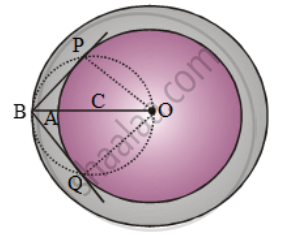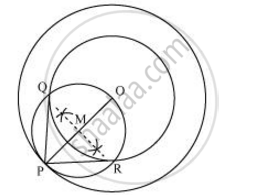Advertisements
Advertisements
प्रश्न
Construct a tangent to a circle of radius 4 cm from a point on the concentric circle of radius 6 cm and measure its length. Also verify the measurement by actual calculation.
उत्तर १
In order to do the desired construction,

we follow the following steps:
Step I: Take a point O on the plane of the paper and draw a circle of radius OA = 4 cm. Also, draw a concentric circle of radius OB = 6 cm.
Step II: Find the mid-point C of OB and draw a circle of radius OC = BC. Suppose this circle intersects the circle of radius 4 cm at P and Q.
Step III: Join BP and BQ to get the desired tangents from a point B on the circle of radius 6 cm.
By actual measurement, we find the
BP = BQ = 4.5 cm
Justification: In ∆BPO, we have
OB = 6 cm and OP = 4 cm
`OB^2 = BP^2 + OP^2 ` [Using Pythagoras theorem]
`\Rightarrow BP=\sqrt{OB^{2}-OP^{2}`
`\Rightarrow \sqrt{36-16}=\sqrt{20}=4.47 ~= 4.5 `
Similarly, BQ = 4.47cm ≈ 4.5 cm
उत्तर २
Tangents on the given circle can be drawn as follows.
Step 1
Draw a circle of 4 cm radius with centre as O on the given plane.
Step 2
Draw a circle of 6 cm radius taking O as its centre. Locate a point P on this circle and join OP.
Step 3
Bisect OP. Let M be the mid-point of PO.
Step 4
Taking M as its centre and MO as its radius, draw a circle. Let it intersect the given circle at the points Q and R.
Step 5
Join PQ and PR. PQ and PR are the required tangents.

It can be observed that PQ and PR are of length 4.47 cm each.
In ΔPQO,
Since PQ is a tangent,
∠PQO = 90°
PO = 6 cm
QO = 4 cm
Applying Pythagoras theorem in ΔPQO, we obtain
PQ2 + QO2 = PQ2
PQ2 + (4)2 = (6)2
PQ2 + 16 = 36
PQ2 = 36 − 16
PQ2 = 20
PQ = `2sqrt5`
PQ = 4.47 cm
Justification
The construction can be justified by proving that PQ and PR are the tangents to the circle (whose centre is O and radius is 4 cm). For this, let us join OQ and OR.

∠PQO is an angle in the semi-circle. We know that angle in a semi-circle is a right angle.
∴ ∠PQO = 90°
⇒ OQ ⊥ PQ
Since OQ is the radius of the circle, PQ has to be a tangent of the circle. Similarly, PR is a tangent of the circle.
APPEARS IN
संबंधित प्रश्न
Draw a line segment AB of length 8 cm. Taking A as centre, draw a circle of radius 4 cm and taking B as centre, draw another circle of radius 3 cm. Construct tangents to each circle from the centre of the other circle.
Draw a circle of radius 4 cm. Draw two tangents to the circle inclined at an angle of 60° to each other.
Using ruler and compasses only construct a triangle ABC in which BC = 4 cm, ∠ACB = 45° and perpendicular from A on BC is 2.5 cm. Draw a circle circumscribing the triangle ABC and measure its radius.
Construct a circle, inscribing an equilateral triangle with side 5.6 cm.
Draw a circle of radius 3 cm. Form a point P, 7 cm away from the centre of the circle, draw two tangents to the circle. Also, measure the lengths of the tangents
Draw a line segment AB of length 8 cm. Taking A as centre , draw a circle of radius 4 cm and taking B as centre , draw another circle of radius 3 cm. Construct tangents to each circle form the centre of the other circle.
Draw a circle of radius 4.2. Draw a pair of tangents to this circle inclined to each other at an angle of 45°
Draw a circle of radius 32 cm. Draw a tangent to the circle making an angle 30° with a line passing through the centre.
Draw a circle of radius 4 cm. From a point 6 cm away from its centre, construct a pair of tangents to the circle and measure their lengths.
Draw a circle of radius 4 cm. Take a point P outside the circle without using the center at the circle. Draw two tangents to the circle from point P.
